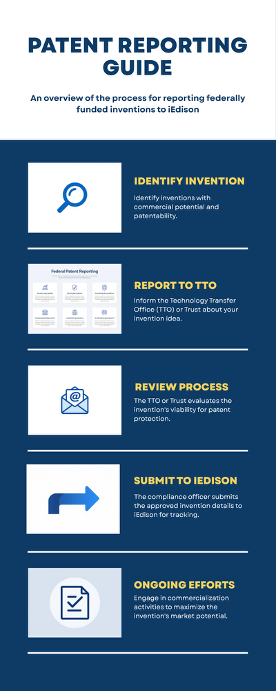Compliance Overview
Welcome to the Compliance Overview page, your resource for understanding federal patenting compliance and iEdison reporting requirements. The Biomedical Innovation Unit (BIU) at the University of Puerto Rico Medical Sciences Campus is here to help researchers navigate federal regulations regarding intellectual property (IP), patents, and the Bayh-Dole Act. This page provides important guidance on the disclosure process, the roles involved, and how iEdison is used to ensure compliance with the Bayh-Dole Act.
Federal compliance is essential for protecting and commercializing innovations resulting from federally funded research. This page outlines key compliance topics, investigator responsibilities, and the process for submitting inventions to the campus compliance officer via the Technology Transfer Office (OPITT) or Trust for eventual reporting in iEdison.
Key Compliance Topics:
Bayh-Dole Act Basics
The Bayh-Dole Act (1980) allows institutions like the University of Puerto Rico to retain ownership of inventions resulting from federally funded research. Researchers and institutions must comply with the Act to ensure the protection, commercialization, and proper reporting of these inventions.
Key Elements of the Bayh-Dole Act:
- Invention Disclosure: Inventions resulting from federally funded projects must be disclosed to the institution within 2 months of discovery or public disclosure.
- Rights Assignment: The institution retains the right to file a patent for inventions, unless the researcher retains the rights to it.
- Federal Government’s March-in Rights: In some cases, if an invention is not being developed or commercialized, the federal government has the right to intervene and ensure that the invention is utilized.
For more information on the Bayh-Dole Act, visit the official Bayh-Dole Act.
iEdison Reporting Overview
iEdison is an interagency online reporting system for recipients of federal funding agreements to report subject inventions to the federal funding agency and complete other reporting as required by the Bayh-Dole Act and its implementing regulations. The platform is used by institutions like the University of Puerto Rico to ensure compliance with federal invention reporting requirements, allowing the timely submission of disclosures and tracking of patents.
Key Aspects of iEdison Reporting:
- Invention Disclosure: Researchers are responsible for reporting inventions to the OPITT or Trust when they determine that the invention may be patentable. Once the OPITT/Trust reviews and approves the invention, it is then submitted by the campus compliance officer into iEdison.
- Timely Reporting: Once the invention has been approved by the OPITT or Trust, the campus compliance officer will submit it to iEdison, ensuring compliance with federal patenting regulations.
To ensure proper compliance, researchers are responsible for timely disclosure of their inventions to the OPITT or Trust, but iEdison reporting is managed by the campus compliance officer.
For more details about iEdison, visit the official iEdison Portal.
Investigator Responsibilities
As an investigator, your role in the compliance process is essential for initiating the disclosure of an invention. Researchers must submit their inventions to the OPITT or Trust for evaluation when they consider the invention to be patentable. After the review and approval process by the OPITT/Trust, the campus compliance officer will then handle the actual submission to iEdison.
Key Responsibilities for Researchers:
| Step | Action Required | Details |
|---|---|---|
| 1. Initial Identification | Determine if the invention is potentially patentable | Inventors must assess whether the invention has novelty, utility, and non-obviousness to be patentable. |
| 2. Disclose to OPITT/Trust | Submit an Invention Disclosure Form to the Technology Transfer Office (OPITT) or Trust | Disclosure must occur within 2 months of determining the invention is potentially patentable. This triggers the disclosure timeline. |
| 3. Work with OPITT/Trust | Provide necessary details and data to OPITT/Trust for review | The inventor must collaborate with the OPITT/Trust, providing required technical details. |
| 4. Assist with Patent Filing | Assist in the preparation of the patent application | The inventor provides necessary data for patent filing, though OPITT/Trust handles the actual submission. |
| 5. Maintain Confidentiality | Avoid public disclosure until the patent is filed | Public disclosure can trigger a statutory bar, which is a 1-year deadline for filing a patent application. |
| 6. Provide Updates to Compliance Officer | Report the invention’s status to the campus compliance officer for iEdison reporting | After disclosure to OPITT/Trust, the campus compliance officer submits the invention to iEdison for reporting. |
| 7. Cooperate in Commercialization | Engage in commercialization efforts with OPITT or Trust | The inventor works with commercialization partners to bring the invention to market. |
| 8. Report Invention Use | Support post-patent filing efforts and public benefit tracking | Inventor ensures the invention is being utilized effectively and provides any necessary reports. |
Quick Compliance Timeline
This timeline outlines the key steps involved in disclosing an invention and ensuring compliance with the Bayh-Dole Act through iEdison.
 |
|
Training Videos and Resources for Complaince Officers
To help you understand iEdison and federal compliance, we’ve gathered useful resources, including training videos and guides. These materials will help you understand the disclosure process and how to ensure compliance with the Bayh-Dole Act.
Essential iEdison Training Resources: (Call To Action default)
- How to Navigate iEdison – Learn how to navigate iEdison.
- How to Report Inventions in iEdison – Detailed walkthrough on submitting inventions for disclosure.
Related Resources
Here are additional resources that will help you in the invention disclosure and compliance process:
- iEdison Portal – The official portal for invention disclosure and federal compliance.
- SBIR/STTR Programs – Learn about funding opportunities that support commercialization.
- University of Puerto Rico IP Policies – Institutional policies on intellectual property and patenting.
- Tech Transfer Office – For assistance with patent filings and commercialization strategies.
Contact Us
If you have any questions or need further assistance, feel free to reach out to the Biomedical Innovation Unit. Once available, we will provide specific contact details for the iEdison Compliance Officer.
- Phone: (787) 763-9401
- Email: bic.rcm@upr.edu
Our team is here to help you through every step of the compliance and patenting process!
